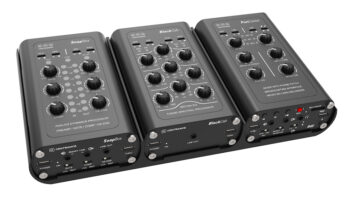
Let’s talk about operational amplifiers. I know, I know…you’re thinking, “Let’s not.” Still, that little analog integrated circuit can teach us something.
An operational amplifier is all about producing huge amounts of gain. Left to its own devices, even the tiniest input will saturate the output. Worst case, it will oscillate uncontrollably and produce chaos instead of gain.
Engineers figured out that applying negative feedback could tame the gain, but at some frequencies, phase shifts would occur, create positive feedback, and the op amp would do the equivalent of sticking a mic in front of the P.A. at a concert—and we were back to chaos.
One solution was external compensation to reduce the gain at the frequency where positive feedback occurred. Another solution was putting internal compensation within the chip itself. Although that made designing with op amps easier, it complicated tweaking the compensation for optimum performance. In closed systems, everything has tradeoffs.
What matters here is that humans behave similarly. Social media— and the music industry—are good examples, especially as they become increasingly intertwined.
Social media is capable of huge amounts of gain. Even a tiny input signal can blow up, go viral and saturate the medium. In forums, one person can make one comment that initiates a flood of crazed responses that destabilize the discussion. As op amps show us, not all feedback is “good” feedback.
So, social media mimics how op amps introduce stability. Algorithms that flag objectionable posts are like internal compensation. External compensation comes from the people who act like hall monitors, and make judgment calls about appropriateness. These efforts try to prevent the system from regenerating into an echo chamber of feedback hell, because when feedback spirals out of control, chaos re-enters.
BUT WHAT ABOUT MUSIC?
Now consider the music industry’s feedback process. In the days of big studios, there was a balance between musicians wanting to push the envelope, and professional engineers and producers whose feedback kept artists from running off the rails. The cost of studio time was external compensation that kept sessions finite (usually). The labels and retailers also provided feedback, so multiple mechanisms promoted stability within the industry. Then Napster happened, ramped up the gain—and chaos ensued.
These days, the balance between uncontrolled, chaotic feedback and keeping the system stable has tilted toward stability. Even seemingly major changes, like TikTok becoming more important to musicians than YouTube, retains stability from the consumer’s standpoint—it’s just a different URL.
Open Channel: The Subscription Kerfuffle
Open Channel: In Praise of Things That Destroy Music
Meanwhile, many musicians and engineers apply internal compensation that prioritizes following “best practices,” like quantizing, comping and pitch correction. The system rewards music that fits into stable algorithms: Be similar enough to what gets traction, and you’ll be rewarded for your good behavior.
Music has gone from “no rules” to “follow the rules,” and the compensation applied to making “perfect” recordings works against making ground-breaking ones. Is the internal compensation of algorithms that limit the listener’s ability to discover music outside of defined genres doing us any favors?
Op amps teach us that a system with unlimited chaos is a problem—but controlled chaos can serve us well. Today, the feedback applied to the music industry has kept it stable. After the upheaval of the last several decades, it’s understandable that stability is a relief. Streaming is the new distribution medium. Stream numbers determine payments. Piracy of physical media no longer exists, because physical media is becoming extinct. A handful of companies control most music distribution. All is well in the kingdom…
In theory. But is that really what we want? Do we truly want our mixes to sound like other mixes because an algorithm says we should? Do listeners get excited about music, or do they just enjoy it?
AND WHAT ABOUT IMMERSIVE?
Music and popular culture thrive on change—our jobs depend on it. While I doubt anyone wants something resembling Napster-fueled, all-out chaos, surround (oh, sorry, I mean “immersive audio”) could be the element that adds a tantalizing element of instability to music and recording.
Cirque du Soleil showed what surround can do with its The Beatles: Love show. The Optima6 audio-video guide electronics brought surround to immersive art exhibits. Installations from artists like Robert Henke (cocreator of Ableton Live) and Jacqueline Kiyomi Gork turn surround into art. And for movie surround, it’s hard to beat Gravity.
What about music? Surround is caught between the chaos of multiple formats, and the stability labels seem to crave that comes from reissuing older material in surround—hey, that model worked before, right?
Well, it’s not going to work again, because the industry has it backwards. It’s the formats that need to become stable, and the art that needs to get chaotic. I don’t want to be told I gotta hear Springsteen in surround. I want to be told about musicians, engineers and producers who are creating a sonic experience unlike anything I’ve experienced. I’m waiting for someone to do the surround equivalent of taking a mic, putting it up against the P.A.’s speaker, and unleashing uncontrollable feedback—just to see what happens.
Surround beckons. After the failures of QS/SQ/CD-4 in the ’70s and DVD-A SACD in the early 2000s, is the music industry going to blow the promise of surround for a third time?
It sure looks like it.
Please, prove me wrong.





